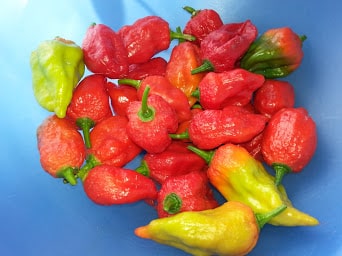As we hurtle towards our first anniversary as farmers, it’s time to look back at the rollercoaster year it has been. We’ve had our struggles, triumphs, frustrations, and successes, but at no point in this one year did either of us regret the decision to buy this land and try our hand at organic farming. Both Bandra Rose and I have been told on many occasions that we are ‘terribly brave’ (a euphemism perhaps for ‘terribly stupid’), but I cannot begin to tell you what an absolute joy and learning experience this last year has been.
As I try to recount and relive the last year, a philosophical sentence comes to mind; “If a tree falls in a forest and no one is around to hear it, does it make a sound?” In our case, this is literal as well as figurative! So, without further ado, here are all the metaphoric and literal trees that fell in the past year.
Harvest
The rains were a mixed blessing. On the one hand, the (hardly) highway deteriorated into an endless stretch of craters and potholes that would have made the moon proud and increased our travel time by over an hour – each way! On the other hand, the farm loved the rains and overwhelmed us with its bounty. Gargantuan patrel [Calocacia] leaves, giant pumpkins, bionic doodhis (lauki/bottle gourd), loads of bhindi (ladyfinger), and cucumber. We would return home each time with the car heaving with the weight of our produce. It indeed was a monsoon of plenty for us.
Black Rice
The small patch of black rice we had planted using our child labour grew and blossomed despite all reservations from S&M, and by late September, we had our first harvest of black rice. Nutty, fragrant and gloriously black
Drip Irrigation
We planned and planted over 600 trees in about 4 acres of land. Mango, Cashew, Banana, Cashew, Chickoo, Papaya, Kokum, and Bay Leaf saplings have been planted and are thriving – touch wood!. We need to care for them for anywhere between 4-6 years before they bear fruit. To reduce labour costs and conserve water, we decided to instal a drip irrigation system. After getting several prohibitive quotes, our valiant consultant S took it upon himself to plan and instal the system. It really has been a blessing as our full-time Imp is now relieved of his daylong plant-watering duty and can turn his attention to our other experiments.
Tool-shed and Toilet
Having decided we were not going to build a ‘farmhouse’ of any kind on this land and use it exclusively for agriculture, we found we had no place to store all the motley farm equipment that was slowly building up. Wheelbarrows, brush cutter, drums for water, hoes, shovels, pressure pumps…the equipment list was expanding, and it was unfair to ask the Imp to lug it all back to his home in the village. A barn or tool shed was the need of the hour, along with a toilet!! Holding it in till we reached a decent toilet was starting to take a toll on our bladders as well as on our physical and mental well-being. Both of us were agreed that there would be no ugly concrete blocks on our pretty organic farm. So, laterite or Chira stone was used, and two days before Christmas, our gingerbread-looking tool shed and toilet were ready for use. A huge relief and so pretty!
Oyster Mushrooms
When we first bought the farm, Bandra Rose had been keen to use some of the land to build a mushroom shed and grow oyster mushrooms. After looking for appropriate spots, we found a rocky bit of land that was of no use for any cultivation and the Imp and his pals constructed a dark and roomy shed. The learning curve was sharp and steep, but they threw themselves in it and lo and behold, we soon had our first oyster mushroom harvest. Insanely easy to grow and world-class. We plan to expand this to double and even triple our yield in the coming months and hope we will soon be able to go commercial
Vegetables
Once the rice had been harvested, we got to work on a vegetable patch. By the time we had cleared the land and started our planting, the days were getting warmer, and we realised how difficult it is for young plants to survive the blazing sun. The same vegetables that thrived and grew in abundance during the monsoon are struggling and shrivelling under the sun. Spinach, methi (fenugreek) and coriander are no brainers, but growing other vegetables in the sweltering heat is proving to be a challenge. All sorts of explanations are floated at us, ranging from rocky soil and too little water to too much sun. However, these are early days, and we continue to experiment and try all different types of vegetables and grains. This is an ongoing endeavour, and I hope to report some success in the next few months. I must add here that nobody, and I mean nobody for miles around, uses their land for anything but paddy during the four monsoon months. During the other eight months, the lands lie abandoned, and the people from the villages around us tend to their goats or go out to look for work as a daily labour. The idea of using over an acre of land for vegetables, attempting to grow toor dal (arhar dal or yellow pigeon peas), and of course putting up a mushroom shed are all quite alien thoughts in our parts and have our neighbours intrigued.
So, as you can see, many trees did fall in the last twelve months, and I hope you have now heard them.



